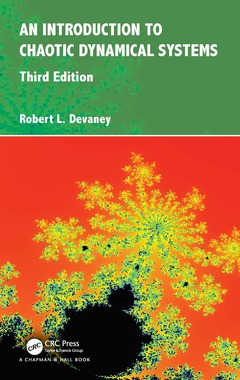An Introduction To Chaotic Dynamical Systems (3rd Ed.)
Auteur : Devaney Robert L.

There is an explosion of interest in dynamical systems in the mathematical community as well as in many areas of science. The results have been truly exciting: systems which once seemed completely intractable from an analytic point of view can now be understood in a geometric or qualitative sense rather easily.
Scientists and engineers realize the power and the beauty of the geometric and qualitative techniques. These techniques apply to a number of important nonlinear problems ranging from physics and chemistry to ecology and economics.
Computer graphics have allowed us to view the dynamical behavior geometrically. The appearance of incredibly beautiful and intricate objects such as the Mandelbrot set, the Julia set, and other fractals have really piqued interest in the field.
This is text is aimed primarily at advanced undergraduate and beginning graduate students. Throughout, the author emphasizes the mathematical aspects of the theory of discrete dynamical systems, not the many and diverse applications of this theory.
The field of dynamical systems and especially the study of chaotic systems has been hailed as one of the important breakthroughs in science in the past century and its importance continues to expand. There is no question that the field is becoming more and more important in a variety of scientific disciplines.
New to this edition:
?Greatly expanded coverage complex dynamics now in Chapter 2
?The third chapter is now devoted to higher dimensional dynamical systems.
?Chapters 2 and 3 are independent of one another.
?New exercises have been added throughout.
I One Dimensional Dynamics
1.A Visual and Historical Tour
2.Examples of Dynamical Systems
3.Elementary Definitions
4.Hyperbolicity
5.An Example: The Logistic Family
6.Symbolic Dynamics
7.Topological Conjugacy
8.Chaos
9.Structural Stability
10.Sharkovsky's Theorem
11.The Schwarzian Derivative
12.Bifurcations
13.Another View of Period Three
14.Period-Doubling Route to Chaos
15.Homoclinic Points and Bifurcations
16.Maps of the Circle
17.Morse-Smale Diffeomorphisms
II Complex Dynamics
18.Quadratic Maps Revisited
19.Normal Families and Exceptional Points
20.Periodic Points
21.Properties of the Julia Set
22.The Geometry of the Julia Sets
23.Neutral Periodic Points
24.The Mandelbrot Set
25.Rational Maps
26.The Exponential Family
III Higher Dimensional Dynamics
27.Dynamics of Linear Maps
28.The Smale Horseshoe Map
29.Hyperbolic Toral Automorphisms
30.Attractors
31.The Stable and Unstable Manifold Theorem
32.Global Results and Hyperbolic Maps
33.The Hopf Bifurcation
34.The Herron Map
Appendix: Mathematical Preliminaries
Robert L. Devaney is currently Professor of Mathematics at Boston University. He received his PhD from the University of California at Berkeley in under the direction of Stephen Smale. He taught at Northwestern University and Tufts University before coming to Boston University in 1980. His main area of research is dynamical systems, primarily complex analytic dynamics, but also including more general ideas about chaotic dynamical systems. Lately, he has become intrigued with the incredibly rich topological aspects of dynamics, including such things as indecomposable continua, Sierpinski curves, and Cantor bouquets. He is also the author of A First Course in Chaotic Dynamical Systems, Second Edition, published by CRC Press.
Date de parution : 11-2021
15.6x23.4 cm
Thèmes d’An Introduction To Chaotic Dynamical Systems :
Mots-clés :
Julia Set; Periodic Points; Chaos; Mandelbrot Set; one-dimensional dynamics; Phase Portrait; higher dimensional dynamics; Dense; complex dynamics; Saddle Node Bifurcation; Topologically Conjugate; Sharkovsky's Theorem; Robert L; Devaney; Cantor Set; Homoclinic Point; Simple Closed Curve; Hyperbolic Periodic Points; Cantor Middle Thirds Set; Complex Analytic Function; Unstable Manifold; Negative Schwarzian Derivative; Montel's Theorem; Bifurcation Diagram; Unstable Sets; Quadratic Map; Hyperbolic Set; Dense Orbit; Backward Orbits; Simple Closed Curves



